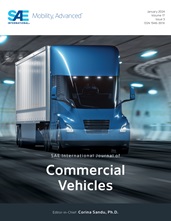Simulation Modeling on Dynamic Stiffness of Leaf Spring Based on Three-link Model
- Features
- Event
- Content
- The leaf spring has significant hysteresis characteristics due to the interleaf friction. The traditional three-link model could not simulate the hysteresis characteristics at all. According to the dynamic load test results one can find that the dynamic stiffness of leaf spring has a nonlinear relationship with the travel distance and the load frequency has a tiny influence on it. Based on the traditional three-link model, this paper proposed a simulation modeling method by introducing torsional friction on the revolute joints. The key parameters including torsional spring stiffness, friction torque preload, stiction transition velocity and max stiction deformation are optimized by combining the ADAMS and OPTIMUS. The comparison analysis between the simulation and test results of front and rear leaf springs have revealed that the maximum average errors are 4.84% and 6.41%, respectively. The proposed simulation modeling method of leaf spring lays a foundation for the high efficiency and precision modeling of vehicles on ride comfort.
- Pages
- 5
- Citation
- Liu, X., Chen, W., Chen, Y., and Zhao, J., "Simulation Modeling on Dynamic Stiffness of Leaf Spring Based on Three-link Model," Commercial Vehicles 10(2):519-523, 2017, https://doi.org/10.4271/2017-01-0421.
